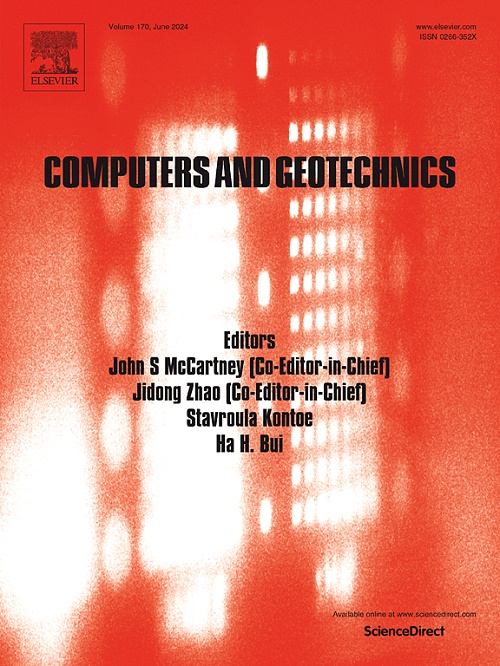受基体-块体焊接状态调节的胶结土-岩石混合物(CSRM)剪切力学行为的多尺度研究
IF 5.3
1区 工程技术
Q1 COMPUTER SCIENCE, INTERDISCIPLINARY APPLICATIONS
引用次数: 0
摘要
本文章由计算机程序翻译,如有差异,请以英文原文为准。
Multiscale investigation of shear mechanical behaviour in cemented soil–rock mixtures (CSRMs) regulated by matrix–block welding states
Soil–rock mixtures (SRMs) are characterized by heterogeneous structural features that lead to multiscale mechanical evolution under varying cementation conditions. However, the shear failure mechanisms of cemented SRMs (CSRMs) remain insufficiently explored in existing studies. In this work, a heterogeneous three-dimensional (3D) discrete element model (DEM) was developed for CSRMs, with parameters meticulously calibrated to examine the role of matrix–block interfaces under different volumetric block proportions (VBPs). At the macroscopic scale, significant influences of the interface state on the peak strength of CSRMs were observed, whereas the residual strength was found to be largely insensitive to the interface cementation properties. Pronounced dilatancy behaviour was identified in the postpeak and residual phases, with a positive correlation with both interface cementation and VBP. Quantitative particle-scale analyses revealed substantial heterogeneity and anisotropy in the contact force network of CSRMs across different components. A highly welded interface was shown to reduce the number of interface cracks at the peak strength state while increasing the proportion of tensile cracks within the interface zone. Furthermore, the welding degree of the interface was found to govern the formation and morphology of shear cracking surfaces at the peak strength state. Nevertheless, a reconstruction method for the shear slip surface was proposed to demonstrate that, at the same VBP, the primary roughness of the slip surfaces remained consistent and was independent of the interface properties. Based on the extended simulations, the peak strength of the weakly welded CSRMs progressively decreased with increasing VBP, whereas further exploration of the enhanced residual strength is needed.
求助全文
通过发布文献求助,成功后即可免费获取论文全文。
去求助
来源期刊

Computers and Geotechnics
地学-地球科学综合
CiteScore
9.10
自引率
15.10%
发文量
438
审稿时长
45 days
期刊介绍:
The use of computers is firmly established in geotechnical engineering and continues to grow rapidly in both engineering practice and academe. The development of advanced numerical techniques and constitutive modeling, in conjunction with rapid developments in computer hardware, enables problems to be tackled that were unthinkable even a few years ago. Computers and Geotechnics provides an up-to-date reference for engineers and researchers engaged in computer aided analysis and research in geotechnical engineering. The journal is intended for an expeditious dissemination of advanced computer applications across a broad range of geotechnical topics. Contributions on advances in numerical algorithms, computer implementation of new constitutive models and probabilistic methods are especially encouraged.
 求助内容:
求助内容: 应助结果提醒方式:
应助结果提醒方式:


